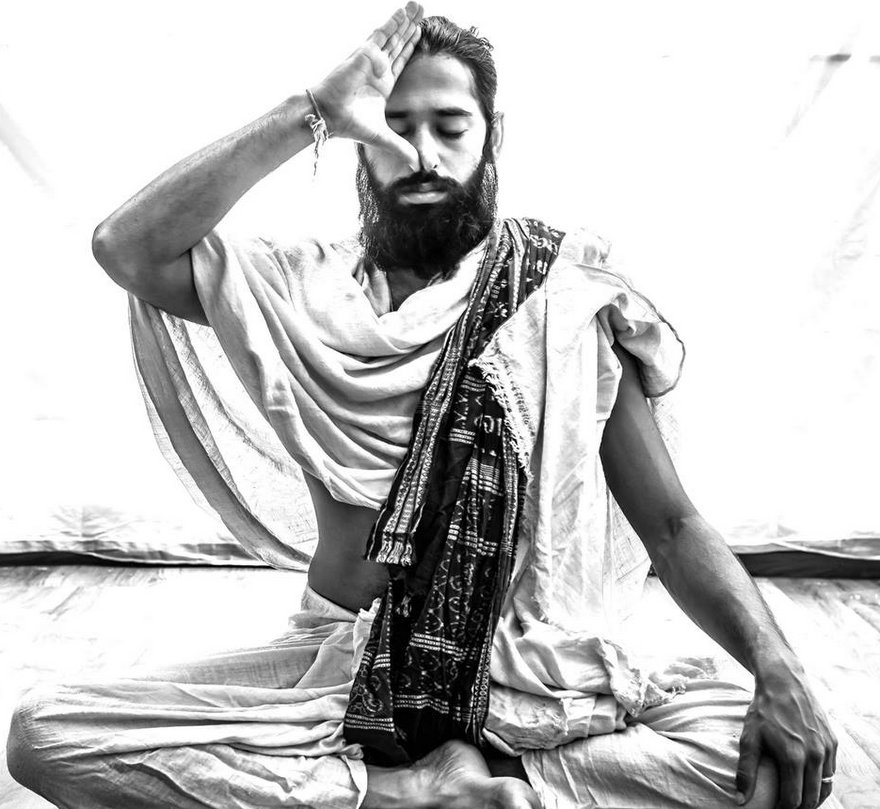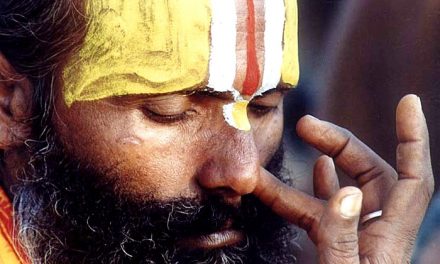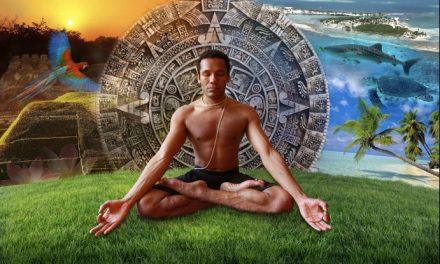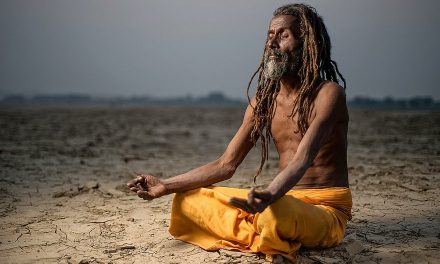Pranayama is an exact science. It is the fourth Anga or limb of Ashtanga Yoga. “Tasmin Sati Svasa prasvasayorgativicchedah Pranayamah”—Regulation of breath or the control of Prana is the stoppage of inhalation and exhalation, which follows after securing that steadiness of posture or seat, Asana. Thus is Pranayama defined in Patanjali Yoga Sutras, Chapter II-49.
‘Svasa’ means inspiratory breath and ‘Prasvasa’ is expiratory breath. Breath is external manifestation of Prana, the vital force. Breath like electricity, is gross Prana. Breath is sthula, gross. Prana is sukshma, subtle. By exercising control over this breathing you can control the subtle Prana inside. Control of Prana means control of mind. Mind cannot operate without the help of Prana. The vibrations of Prana only produce thoughts in the mind. It is Prana that moves the mind. It is Prana that sets the mind in motion. It is the Sukshma Prana or Psychic Prana that is intimately connected with the mind.
[wp_ad_camp_1]
This breath represents the important fly-wheel of an engine. Just as the other wheels stop when the driver stops the fly-wheel, so also other organs cease working, when the Yogi stops the breath. If you can control the fly-wheel, you can easily control the other wheels. Likewise, if you can control the external breath, you can easily control the inner vital force, Prana. The process by which the Prana is controlled by regulation of external breath, is termed Pranayama.
Just as a goldsmith removes the impurities of gold by heating it in the hot furnace, by strongly blowing the blow-pipe, so also the Yogic student removes the impurities of the body and the Indriyas by blowing his lungs, i.e., by practising Pranayama.
The chief aim of Pranayama is to unite the Prana with the Apana and take the united Pranapana slowly towards the head. The effect or fruit of Pranayama is Udghata or awakening of the sleeping Kundalini.
What is Prana?
“He who knows Prana knows Vedas” is the important declaration of the Srutis. You will find in Vedanta Sutras: “For the same reason, breath is Brahman.” Prana is the sum total of all energy that is manifest in the universe. It is the sum total of all the forces in nature. It is the sum total of all latent forces and powers which are hidden in men and which lie everywhere around us. Heat, light, electricity, magnetism are the manifestations of Prana. All forces, all powers and Prana spring from the fountain or common source, ‘Atman’. All physical forces, all mental forces come under the category ‘Prana’. It is force on every plane of being, from the highest to the lowest. Whatever moves or works or has life, is but an expression or manifestation of Prana. Akasa or ether also is an expression of Prana. The Prana is related to mind and through mind to will, and through will to the individual soul, and through this to the Supreme Being. If you know how to control the little waves of Prana working through the mind, then the secret of subjugating universal Prana will be known to you. The Yogi who becomes an expert in the knowledge Of this secret, will have no fear from any power, because he has mastery over all the manifestations of powers in the universe. What is commonly known as power of personality is nothing more than the natural capacity of a person to wield his Prana. Some persons are more successful in life, more influential and fascinating than others. It is all due to the power of this Prana. Such people manipulate everyday, unconsciously of course, the same influence which the Yogi uses consciously by the command of his will. There are others who by chance tumble unaware of this Prana and use it for lower purposes under false names. This working of Prana is seen in the systolic and diastolic actions of the heart, when it pumps the blood into arteries in the action of inspiration and expiration during the course of breathing; in the digestion of food; in the excretion of urine and faecal matter; in the manufacture of semen, chyle, chyme, gastric juice, bile, intestinal juice, saliva; in closing and opening of the eyelids, in walking, playing, running, talking, thinking, reasoning, feeling and willing. Prana is the link between the astral and physical body. When the slender thread-link Prana is cut off the astral body separates from the physical body. Death takes place. The Prana that was working in the physical body is withdrawn into the astral body.
This Prana remains in a subtle, motionless, unmanifested, undifferentiated state during the cosmic Pralaya. When the vibration is set up, Prana moves and acts upon Akasa, and brings forth the various forms. The macrocosm (Brahmanda) and microcosm (Pindanda) are combinations of Prana (energy) and Akasa (matter).
That which moves the steam-engine of a train and a steamer, that which makes the aeroplanes fly in air, that which causes the motion of the breath in lungs, that which is the very life of this breath itself, is Prana. I believe, you have now a comprehensive understanding of the term Prana about which you had a very vague conception in the beginning.
By controlling the act of breathing you can efficiently control all the various motions in the body and the different nerve-currents that are running through the body. You can easily and quickly control and develop body, mind and soul through breath-control or the control of Prana. It is through Pranayama that you can control your circumstances and character and can consciously harmonise the individual life with the cosmic life.
The breath, directed by thought under the control of the will, is a vitalising, regenerating force which you can utilise consciously for self-development; for healing many incurable diseases in your system; for healing others and for other various useful purposes.
It is within your easy reach at every moment of your life. Use it judiciously. Many Yogins of yore, like Sri Jnanadeva, Trailinga Swami, Ramalinga Swami and others, had utilised this breath, this force, the Prana, in a variety of ways. You can also do so, if you practise Pranayama by prescribed breathing exercises. It is Prana that you are breathing rather than the atmospheric air. Inhale slowly and steadily with a concentrated mind. Retain it as long as you can do it comfortably. Then exhale slowly. There should be no strain in any stage of Pranayama. Realise the occult inner life-powers which underlie the breath. Become a Yogi and radiate joy, light and power all around you. Pranavadins or Hatha Yogins consider that Prana Tattva is superior to Manas Tattva, the mind-principle. They say, Prana is present even when the mind is absent during sleep. Hence Prana plays a more vital part than the mind. If you go through the parables in Kaushitaki and Chhandogya Upanishads, when all the Indriyas, mind and Prana fight amongst themselves as to their superiority, you will find that Prana is regarded as the highest of all. Prana is the oldest, for it starts its functioning from the very moment the child is conceived. On the contrary, the organs of hearing, etc., begin to function only when their special abodes, viz., the ears, etc., are formed. Prana is called Jyeshtha and Sreshtha (oldest and best) in Upanishads. It is through the vibrations of psychic Prana that the life of the mind, Sankalpa or thinking is kept up and thought is produced. You see, hear, talk, sense, think, feel, will, know, etc., through the help of Prana and therefore Srutis declare: “Prana is Brahman.”
Seat of Prana
The seat of Prana is heart. Though the Antahkarana is one, yet it assumes four forms, viz., (i) Manas, (ii) Buddhi, (iii) Chitta and (iv) Ahamkara according to the different functions it performs. Likewise, though Prana is one, it assumes five forms viz., (1) Prana, (2) Apana, (3) Samana, (4) Udana and (5) Vyana according to the different functions it performs. This is termed as Vritti Bheda. The principal Prana is called Mukhya Prana. The Prana, joined with Ahamkara, lives in the heart. Of these five, Prana and Apana are the chief agents.
The seat of Prana is the heart; of Apana, the anus; of Samana, the region of the naval; of Udana, the throat; while Vyana is all-pervading. It moves all over the body.
Sub-Pranas and Their Functions
Naga, Kurma, Krikara, Devadatta and Dhananjaya are the five sub-Pranas. The function of Prana is respiration; Apana does excretion; Samana performs digestion; Udana does deglutition (swallowing of the food). It takes the Jiva to sleep. It separates the astral body from the physical body at the time of death. Vyana performs circulation of blood. Naga does eructation and hiccup. Kurma performs the function of opening the eyes. Krikara induces hunger and thirst. Devadatta does yawning. Dhananjaya causes decomposition of the body after death. That man is never reborn, whenever he may die, whose breath goes out of the head, after piercing the Brahmarandhra.
The Colour of Pranas
Prana is said to be of the colour of blood, red gem or coral. Apana which is in the middle, is of the colour of Indragopa (an insect of white or red colour). Samana is of the colour between that of pure milk or crystal or of oily and shining colour, i.e., of something between both Prana and Apana. Udana is of Apandura (pale white) colour and that of Vyana, resembles the colour of archil (or that of ray of light).
The Length of the Air-Currents
This body of Vayu is 96 digits (6 feet) in length as a standard. The ordinary length of the air-current, when exhaled is 12 digits (9 inches). In singing, its length becomes 16 digits (1 foot), in eating it comes to 20 digits (15 inches), in sleeping 30 digits (22 1/2 inches), in copulation 36 digits (27 inches) and in doing physical exercise it is much more than that. By decreasing the natural length of the expirer air-currents (from 9 inches), life is prolonged and by increasing the current, duration of life is decreased.
The Centering of the Prana
Inhaling the Prana from outside, filling the stomach with it, centre the Prana with the mind, in the middle of the navel, at the tip of the nose, and at the toes, during the ‘Sandhyas’ (sunrise and sunset) or at all times. Thus the Yogi is freed from all diseases and fatigues. By centering this Prana at the tip of the nose he obtains mastery over the elements of the air; by centering at the middle of his navel, all diseases are destroyed; by centering at the toes, his body becomes light. He who drinks air through the tongue destroys his fatigue, thirst and many other diseases. For him who drinks the air with his mouth, during the two Sandhyas and the last two hours of the night, within three months, the auspicious Sarasvati (Goddess of speech) is present in his vak (speech), i.e., he becomes eloquent and learned. In six months he is free from all diseases. Drawing the air at the root of the tongue, the wise man thus drinking nectar enjoys all prosperity.
The Lungs
It will not be out of place here to mention a word on lungs and their functions. The organs of respiration consist of two lungs, one on either side of the chest and the air passages that lead to them. They are located in the upper thoracic cavity of the chest, one on each side of median line. They are separated from each other by the heart, the greater blood vessels and the larger air-tubes. The lungs are spongy, porous and their tissues are very elastic. The substance of the lungs contains innumerable air-sacs, which contain air. After post-mortem, when it is placed in a basin of water, it floats. They are covered by a delicate serous membrane called the pleura which contains serous fluid to prevent friction of the lungs, during the act of breathing. One wall of the pleura closely adheres to the lungs. The other wall is attached to the inner wall of the chest. Through this membrane the lungs are fixed to the wall of the chest. The right lung consists of three lobes. The left lung contains two lobes. Each lung consists of an apex and a base. The base is directed towards the diaphragm, the muscular septum, the dividing wall between throat and abdomen. The apex situated above, near the root of the neck. It is the base that gets inflamed in Pneumonia. The apex of the lung which does not get proper supply of oxygen gets affected by consumption. It affords favourable nidus or breeding ground for Tubercle Bacilli (T.B.). By the practice of Kapalabhati and Bhastrika Pranayamas and deep breathing exercises, these apices get good supply of oxygen and thus phthisis is obviated. Pranayama develops the lungs. He who practises Pranayama will have a powerful, sweet, melodious voice.
The air-passage consists of the interior of the nose, pharynx or throat, larynx or the wind box, or sounding box, which contains two vocal cords, trachea or windpipe: right and left bronchi and the smaller bronchial tubes. When we breathe, we draw in the air through the nose and after it has passed through the pharynx and larynx, it passes into the trachea or windpipe, thence into the right and left bronchial tubes, which in turn, subdivide into innumerable smaller tubes called bronchioles, and which terminate in minute subdivisions in the small air-sacs of the lungs, of which the lungs contain millions. The air-sacs of the lungs when spread out over an unbroken surface, would cover, an area of 1,40,000 square feet.
The air is drawn into the lungs by the action of the diaphragm. When it expands, the size of the chest and lungs is increased and the outside air rushes into the vacuum thus created. The chest and lungs contract, when diaphragm relaxes and the air is expelled from the lungs.
It is through vocal cords that are located in the larynx that sound is produced. Larynx is the sounding box. When the vocal cords are affected by too much straining, as in singing and continuous lecturing, the voice becomes hoarse. In females these cords are shorter. Hence they have a sweet melodious voice. The number of respiration per minute is 16. In pneumonia it is increased to 60, 70, 80 per minute. In Asthma, the bronchial tubes become spasmodic. They contract. Hence there is difficulty in breathing. Pranayama removes the spasm or constriction of these tubes. A small membranous flat cap covers the upper surface of larynx. It is called Epiglottis. It prevents the food particles or water from entering into the respiratory passage. It acts the part of a safety valve. When a small particle of food tries to enter the respiratory passage, cough comes in and the particle is thrown out.
Lungs purify the blood. The blood starts in its arterial journey, bright-red and rich-laden with life-giving qualities and properties. It returns by the venous route, poor, blue-laden with the waste matter of the system. Arteries are tubes or vessels that carry pure oxygenated blood from the heart towards the different parts of the body. Veins are vessels or tubes that carry back impure blood from the different parts of the body. The right side of the heart contains impure venous blood. From the right side of the heart the impure blood goes to the lungs, for purification. It is distributed among the millions of tiny air-cells of the lungs. A breath of air is inhaled and the oxygen of the air comes in contact with the impure blood through the thin walls of the hair-like blood-vessels of the lungs called pulmonary capillaries. The walls of the capillaries are very thin. They are like muslin cloth or sieve. Blood oozes out or exudes readily. Oxygen penetrates through the walls of these thin capillaries. When the oxygen comes in contact with the tissues a form of combustion takes place. The blood takes up oxygen and releases carbonic acid gas generated from the waste products and poisonous matter, which has been gathered up by the blood from all parts of the system. The purified blood is carried by the four pulmonary veins to the left auricle and thence to the left ventricle. From the ventricle it is pumped into the biggest artery, aorta. From aorta, it passes into the different arteries of the body. It is estimated that in a day 35,000 pints of blood traverses the capillaries of the lungs for purification.
From the arteries the pure blood goes into the thin capillaries. From the capillaries the lymph of the blood exudes, bathes and nourishes the tissues of the body. Tissue respiration takes place in the tissues. Tissues take up the oxygen and leave the carbon dioxide. The impurities are taken by the veins to the right side of the heart.
Who is the creator of this delicate structure? Are you feeling the invisible hand of God behind these organs? The structure of this body bespeaks undoubtedly of the omniscience of the Lord. The Antaryamin or the Indweller of our hearts supervises the working of the inner factory as Drashtha. Without His presence, heart cannot pump blood into the arteries. Lungs cannot carry out the process of purifying the blood. Pray. Pay your silent homage to Him. Remember Him at all times. Feel His presence in all the cells of the body.














